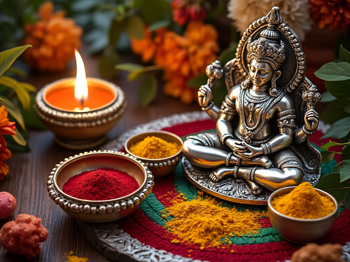Lakshmi Puja holds profound spiritual and cultural significance in Hinduism. It is believed that Goddess Lakshmi visits the cleanest and most well-lit homes on the night of Diwali, bringing with her blessings of wealth, health, and prosperity. The puja is not just a ritualistic practice but a symbolic act of preparing oneself to receive divine grace. By worshipping Lakshmi, devotees seek to cultivate virtues of generosity, compassion, and respect, aligning themselves with the goddess’s qualities. The puja also reinforces the importance of ethical and righteous living as the foundation of true prosperity.
- Attracts Prosperity: Performing Lakshmi Puja is believed to bring financial stability, abundance, and success in various ventures.
- Promotes Positive Energy: The ritual purifies the home environment, driving away negativity and inviting positive, uplifting energies.
- Enhances Mental Peace: Engaging in the puja fosters a sense of peace, reducing stress and anxiety, and promoting mental well-being.
- Strengthens Family Bonds: The puja is often a family activity, fostering unity and togetherness among family members.
- Encourages Ethical Living: By honoring Lakshmi, devotees are reminded to uphold values like honesty, integrity, and charity, which are essential for sustained prosperity.
- Spiritual Growth: The worship of Goddess Lakshmi is also a step towards spiritual advancement, encouraging devotees to seek wealth not just in material terms but in spiritual fulfillment as well.
- Removes Obstacles: The puja is believed to remove obstacles in both personal and professional life, paving the way for success and happiness.
Step-by-Step Procedure to Perform Lakshmi Puja
Performing Lakshmi Puja during Diwali or on other auspicious days is a meaningful and spiritual practice. Below is a detailed guide on how to conduct the puja:
1. Preparation
- Clean the House: Thoroughly clean your home, especially the area where you will perform the puja, as Goddess Lakshmi is believed to reside in cleanliness.
- Decorate the Puja Area: Decorate the puja area with rangoli (colorful patterns made on the floor), flowers, and oil lamps (diyas). Place a clean cloth on a raised platform or altar.
- Gather Puja Items: Prepare the necessary puja items, including:
- A statue or picture of Goddess Lakshmi
- A statue or picture of Lord Ganesha (remover of obstacles)
- Kalash (a pot filled with water or rice and a coconut placed on top)
- Mango leaves
- Puja thali (plate) with kumkum, turmeric, rice grains, betel leaves, betel nuts, fruits, sweets, flowers, incense sticks, ghee lamp, and coins
- Panchamrit (a mixture of milk, yogurt, honey, sugar, and ghee)
2. Kalash Sthapana (Setting up the Kalash)
- Place the kalash in the center of the altar and fill it with water or rice.
- Place five mango leaves around the neck of the kalash.
- Place a coconut on top of the kalash, wrapped in a red cloth with some turmeric and kumkum applied to it.
3. Invoking Lord Ganesha
- Begin the puja by invoking Lord Ganesha, the remover of obstacles, to ensure the puja is carried out smoothly.
- Light an oil lamp and incense sticks.
- Chant Ganesha mantras and offer flowers, rice grains, and sweets to the deity.
4. Lakshmi Puja
- Dhyana (Meditation): Sit in a comfortable position and meditate on Goddess Lakshmi, visualizing her presence and blessings.
- Aavahana (Invocation): Invite Goddess Lakshmi to the puja by chanting her mantras, such as "Om Shreem Hreem Shreem Mahalakshmiyai Namah."
- Offerings:
- Flowers: Offer fresh flowers to the goddess while reciting her 108 names or mantras.
- Panchamrit Abhishekam: Bathe the idol or picture of Lakshmi with panchamrit, followed by clean water. Wipe the idol and dress it with new clothes or a cloth.
- Kumkum and Turmeric: Apply kumkum and turmeric to the goddess's forehead and feet.
- Naivedya (Food Offering): Offer fruits, sweets, and other food items prepared for the puja.
- Coins and Jewelry: Place coins, jewelry, and other valuables near the idol as an offering to Lakshmi.
- Aarti: Perform the aarti (ritual waving of the lighted lamp) by circling the lamp clockwise in front of the deity while singing the aarti song or chanting mantras.
- Lighting Lamps: Light lamps or diyas and place them around the house and near the entrance to welcome Goddess Lakshmi.
5. Prayers and Mantras
- Recite Lakshmi stotras (hymns) or mantras, such as the Lakshmi Ashtottara Shatanamavali (108 names of Lakshmi) or Lakshmi Chalisa, to praise and honor the goddess.
- Offer heartfelt prayers for prosperity, health, and happiness for all family members.
6. Conclusion of the Puja
- Pradakshina (Circumambulation): Circumambulate the puja area or the altar three times in a clockwise direction.
- Pushpanjali (Flower Offering): Offer flowers at the feet of Goddess Lakshmi and seek her blessings.
- Aarti and Distribution of Prasad: Perform a final aarti, and then distribute the prasad (blessed food) among the family members and neighbors.
- Thanksgiving: Thank Goddess Lakshmi for her presence and blessings, and respectfully request her to take leave after the puja is complete.
7. Post-Puja Rituals
- After the puja, keep the lamps burning for as long as possible, as it is believed to attract more positive energy.
- Distribute prasad and gifts to family members, friends, and the needy as an act of charity and goodwill.
By following these steps with devotion and sincerity, the Lakshmi Puja can bring peace, prosperity, and divine blessings into your life.




